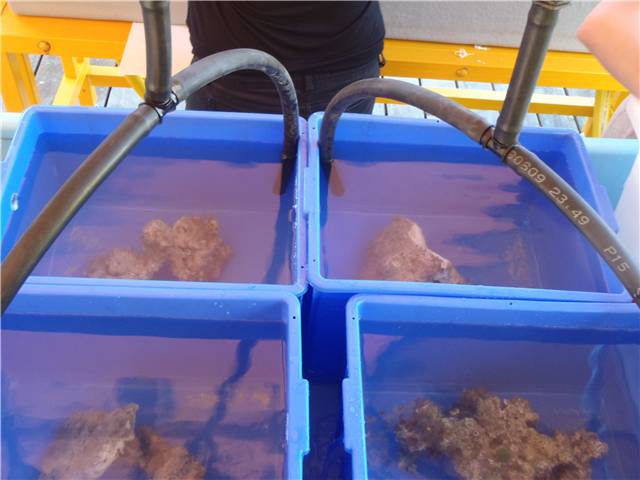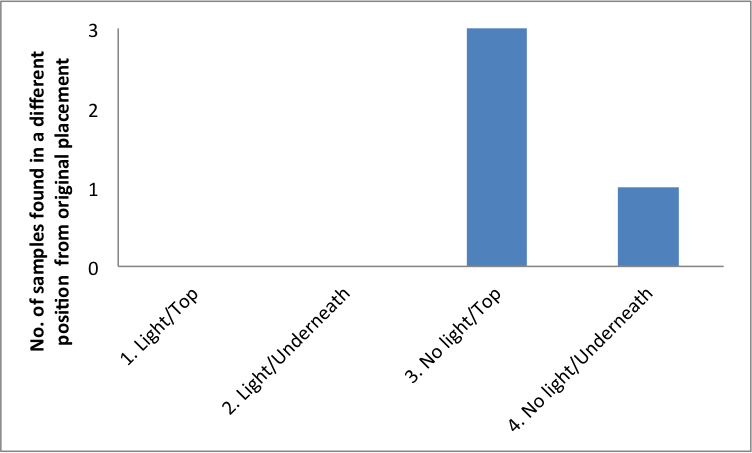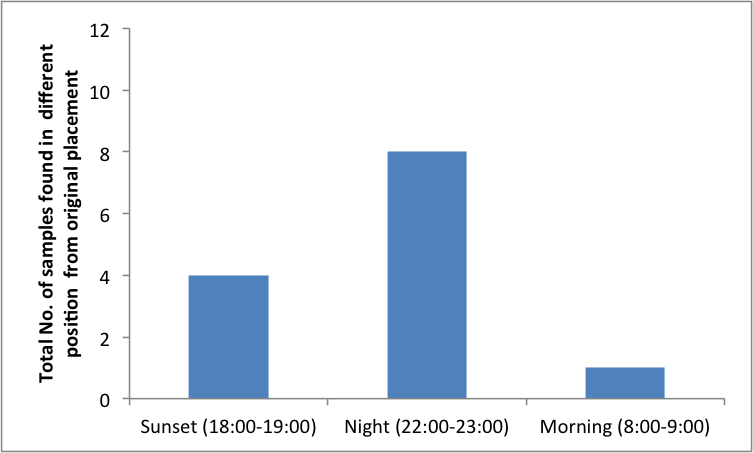Behaviour
Focus Topic: Determining the nocturnality of the short-tailed latirus (Latirus polygonus) and the endogenous circadian rhythm as a potential underlying mechanism.
Background
The short-tailed latirus (Latirus polygonus) is a marine snail with a spindle-shaped shell, belonging to the family Fasciolariidae (WoRMS 2010, Gastropods.com 2011). Members of this family are known to be carnivorous, and feed mainly on other gastropods and bivalves (Snyder 2003). Little species-specific information is available on this species, suggesting a need for further studies to be conducted on this species. In this section, details of a pioneer study conducted on their ecological behaviours will be provided.
The primary question arose when sampling for these snails in the reef crest of Heron Island. Most, if not all of the snails were found underneath the coral boulders in the reef crest during daytime. This behaviour resembles the tropical abalone (Haliotis asinina), also found under boulders on the reef crest of Heron Island (Mcnamara and Johnson 1995). They are known to be nocturnal grazers of algal turfs (Counihan et al. 2001), which explain their behaviours, but this cannot be the same for the L. polygonus due to being carnivorous in the first place, and lack of research to conclude whether they are nocturnal.
Specific diets of the L. polygonus are yet to be determined, but many gastropods including the opisthobranchs, which are potential prey items, are also known to be nocturnal and come out from underneath the boulders at night to graze (Coleman 2008). From this, it can be suggested that the L. polygonus also emerge from underneath the boulders at night to feed on these gastropods. Sampling difficulties at nighttime could not confirm whether they actually come out from underneath the boulders at night, so the primary focus of this study was to determine whether their behaviour was due to simple taxis responses or not. The two most likely taxis types that could cause their behaviour (photo- or geotaxis) were tested for in the first part of this study.
Behavioural study (part 1):
Are photo- or geotactic characteristics responsible for the observed behaviours of Latirus polygonus?
Hypothesis
Latirus polygonus are found on the under-side of boulders during daytime due to their photo- and/or geotactic characteristics.
Methods
To test the hypothesis, four treatment types were applied-
1. Light/Top (light applied from above, and samples placed on the upper-side of boulders)
2. Light/Underneath (light applied from below the boulders, and samples placed on the under-side of boulders)
3. No light/Top (no light applied, with samples placed on the upper-side of boulders)
4. No light/Underneath (no light applied, with samples placed on the under-side of boulders)
If the samples were found on the side without light for treatments 1 and 2, this indicates a negative phototactic characteristic. If they were found on the under-side of the boulder for both treatments 3 and 4, this would indicate a positive geotactic characteristic.

A total of 12 samples were collected from the reef crest of Heron Island, giving 3 samples for each treatment. One plastic container (roughly 40x45x60) was used for each treatment, with water circulation systems adjusted to maintain water quality without creating a strong flow (Image 1). Four pieces of coral boulders (roughly 20x20) were chiseled and collected from the field for the treatments as well. An overhead lighting pipe and 3 waterproof flashlights used as light stimuli for treatments 1 and 2. A black garbage bag was used to cover all containers to ensure no extra light stimuli were applied to any of the treatments.
Image 1. Experimental setup of the
behavioural experiment on Latirus polygonus.
Samples were placed onto the boulders for approximately 5 minutes prior to the study, in order to ensure they were properly holding on to the boulders. The boulders were then either left in that position or flipped over depending on their treatment type. After 60 minutes, the garbage bags were taken off and the results were recorded. Results were recorded as either moved or no movement, relative to their starting positions (eg. if samples started on top of the boulder and were not found on top of the boulder after the experiment, they were considered moved, and if they were found on top, they were considered no movement, even if they were in a different position from where they started on top of the boulder).
Results
Results of this experiment are as shown on Figure 1. Both treatments 1 and 2 had no movement, with treatment 3 having all three, and treatment 4 having one of the samples in different positions from their original spot. A simple ANOVA test was attempted using the statistical analysis software R, but failed to produce results due to insufficient number of replications.

Figure 1. Chart showing the number of samples (Latirus polygonus) in different positions from their original placement for 4 different treatments (1. Light/Top, 2. Light/Underneath, 3. No light/Top, and 4. No light/Underneath).
Discussion
Results displayed a high rate of movement in treatments 3 and 4 under dark conditions, as compared to treatments 1 and 2 under light exposure (Figure 1). Treatments 1, 2 and 4 had minimal or no movement, contradictory to predictions. Treatment 3 (No light/Top) had all samples in different positions from their starting point, but none of them were found underneath the boulder and were found on the walls of the container, which rejects the possibility of a positive geotactic characteristic. Therefore, results were insignificant and did not show any sign of taxis responses. Many limitations to this study can be raised such as low sample size and replication numbers, but due to restrictions in available time, the hypothesis was considered rejected for this part of the study.
As such, this still leaves the possibility of these snails possessing a nocturnal characteristic. Even though there were no simple tactic characteristics, one key finding from the first part of the study was their high active rates under dark (no light) conditions. With this in mind, the second part of the study was constructed to reveal the underlying mechanism of their behaviour.
A study conducted by Barnes (1986) revealed that the endogenous circadian rhythm, although not the primary factor, played a role in shaping the behaviour of an intertidal gastropod species Hydrobia ulvae. Similarly, but at a different amplitude, an endogenous circadian rhythm may be what is causing the L. polygonus to show signs of nocturnality. Hence, the second part of the study focused on whether they possess an endogenous circadian rhythm governing their behaviours, or the remaining possibility of it being simply a response to light/dark environment differences.
Behavioural study (part 2):
Are behaviours of Latirus polygonus controlled by an endogenous circadian rhythm? Or is it just a simple light/dark response?
Hypothesis
Latirus polygonus have a strong endogenous circadian rhythm governing their behaviours, and will display more activity during nighttime than in daytime.
Methods
All experimental setups in part 1 of this study was carried on to part 2 to save time and increase replications. The experiment was carried out in the exact same way as in part 1, with time of the experiment now considered as a factor as well. As such, part 1 of this study was considered the first treatment commencing between the times of 18:00-19:00. Two more sets of the experiment was conducted to represent treatments of different times of the day, conducted from 22:00-23:00 and 8:00-9:00. These treatments were considered sunset (18:00-19:00), night (22:00-23:00) and morning (8:00-9:00). All samples were placed back into a larger aquarium between the experiments, and samples for each of the 4 tanks were chosen at random for each experiment.
The total number of samples moved for each treatment (sunset, night, morning) was counted and used to see the different rates of activities. If all treatments had no difference in the total movement of samples with the no light treatments having the most activities, a simple dark/light response is suggested to be the likely mechanism underlying their behaviour. If, on the other hand, the night treatment had a significantly higher number of activity displayed compared to the other two treatments, an endogenous circadian rhythm is likely to be the underlying mechanism.
Results
Results of part 2 of this study are shown in Figure 2. The night treatment had the highest number of activity with 8 samples, with the sunset and morning treatments having lower numbers of 4 and 1 sample(s) respectively. The night treatment had 3 samples move in the light treatments and 5 samples move in the dark treatments, giving a total of 8 active samples. The morning treatment had 1 sample move in the dark treatment, with a total of 1 active sample. A simple ANOVA test was conducted using the statistical analysis software R, producing a p-value of 0.3363 (p>0.05) indicating no significant results were found from this study.

Figure 2. Chart showing the total number of samples (Latirus polygonus) in different positions from their original placement for 3 different treatments (Sunset, Night, and Morning).
Discussion
Results showed that behavioural patterns in L. polygonus seem to be highly influenced by the time of day (Figure 2). This is further reinforced from not only the observed total movement of samples but from the active rates observed for different light stimuli treatments as well. The no light treatment had high active rates in both the sunset and night treatments, but were not nearly as active in the morning treatment. Also, the light treatments were almost equally active as the no light treatments in the night treatment, suggesting the time of day playing a stronger role in controlling their behavioural patterns compared to light stimuli. As a conclusion, although not statistically significant, behavioural patterns in L. polygonus are strongly influenced by their endogenous circadian rhythm rather than simple dark/light responses.
This suggests that the results from Barnes (1986) cannot be directly applied to all gastropods, and the influence of the endogenous circadian rhythm has a wide range of intensity supposedly even between species. Having said this, this does not mean the effect of light can be neglected, and there are other factors that need further consideration as well. A recent study done by Vieira et al. (2010), found that the H. ulvae (same species as the study by Barnes 1986) may not be strongly influenced by the circadian rhythm, but is highly governed by the circatidal rhythm.
This is a factor that was not considered in this experimental approach, and there is a high probability that this may be the strong underlying mechanism for the L. polygonus as well. The night treatment in this study coincides with the low tide, while the other two treatments do not coincide with either the high or low tide. Since the reef crest is exposed at a maximum during low tide, it is logical to think that the L. polygonus become more active, not primarily for feeding, but possibly to hide from predators or to avoid being exposed. This may easily reject the results from this study, and the circatidal rhythm may be the primary mechanism governing their behaviour.
This study had many other limitations as well, including small sample size, lack of replication, limited time available, and equipment restrictions. As mentioned above, further research is to be conducted on their endogenous circatidal rhythm and its effect on their behavioural patterns. Despite the numerous limitations and lack of primary literature, the study was the first to conduct behavioural observations on L. polygonus, providing aims and possibilities for future research on this unique marine gastropod. |